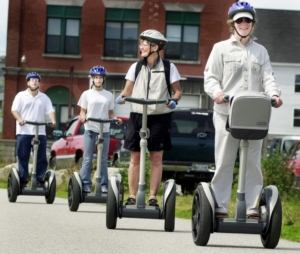Steve Wallace: Readers weigh in on alternative vehicles

Early adopters of the Segway scooter ride in Portland, Maine, in 2004. Powered alternative vehicles such as Segways and powered bikes raise questions about insurance and regulation, Steve Wallace writes.
More answers to questions from readers: Wayne has some very telling suggestions concerning alternate forms of transportation mentioned in last week’s column. He believes all power-assist vehicles,
whether bikes, scooters, chairs, Segways, skateboards and any other newly introduced powered transportation, should be regulated more stringently at the manufacturing and sales level. There should be
a legal liability for resellers and those altering the manufacturers’ specifications to get more speed and power out of their chosen mode of alternate transportation.
My casual conversations with many in this regulatory field have been interesting. Enforcement is spotty at best, and non-existent in most areas of the province. A University of Victoria professor has
sent me the best information to date. Doug stated the regulatory regime is well-established.
Here is what he said: There is a distinction between the “motor-assist cycles” and “limited-speed motorcycles.” The power-assist bike cannot exceed 32 kilometres per hour even with the motor helping
the rider, and the bike must have an assist factor of no more than 500 watts. Downhill speeds of 50 km/h might in some instances be realized. This option does not require a licence or insurance.
The option that does require a rider’s licence and a licence plate, with the accompanying insurance documentation, is the limited speed motorcycle. The speed is rated at no more than 70 km/h and 1,500 watts.
Thanks to Doug for this clarification.
Mike, from French Creek, had a question about insurance. Do any of the alternate-vehicle unlicensed riders carry the necessary insurance, which is mandatory for motor vehicle drivers? The only insurance is theft,
and it is usually associated with home insurance. There is no requirement for an unlicensed vehicle.
Shirley wants to remind every driver to wear the proper footwear when behind the wheel. She had a personal experience with a sandal-strap failure, and will be using a full-foot option from now on.
At the beginning of every driving lesson, we always check for the dreaded flop-flops. The lesson is a no-go until there is a change to appropriate footwear.
Lisa is fearful of cities allowing electric wheelchairs in bike lanes. She wants the rules to remain as they are, restricting them to the sidewalk or side of the road where a sidewalk is not present.
I agree. It is probably just a rumour, but given certain city-council initiatives in the recent past, I can only cringe at the thought.
Ms. Van is very troubled by low-slung wheeled vehicles of all types on our roads. She was almost hit by one, which emerged from a blind side. She wants all low-profile pedestrian-powered vehicles to
be equipped with an identifiable high-flying flag. Good suggestion — let’s make it mandatory.
Roy is seeking advice about travelling on narrow rural roads, particularly gravel roads with no centre line. It is best to use the crown of the road when on gravel roads.
Many in the logging business will drive their pickup trucks in the middle of these unpaved roads. They reduce speed and move right when meeting oncoming traffic.
Riding the crown reduces the chance of loosing control on curves. One can use this same technique on very narrow paved roads, with no visible centre line.
Hitting the accumulated gravel at the shoulder of these roads has surprised many a city dweller.
It is best to hang right and lower the speed on each blind curve and re-establish stability by finding the crown on the straight stretches.
A motorcycle-riding policeman suggests that more drivers and riders use hand signals. This personalizes one’s intention and gets a better response from fellow travellers.
Pointing pedestrians are also a blessing!
Steve Wallace is the owner of Joan Wallace Driving School on Vancouver Island. He is a former vice-president of the Driving Schools Association of the Americas,
a registered teacher and a University of Manitoba graduate.


